Railways of Greece
| Rail transport in Greece | |||||||
|---|---|---|---|---|---|---|---|
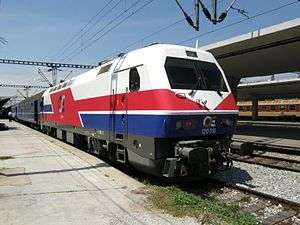 Electric locomotive in Thessaloniki station | |||||||
| Operation | |||||||
| National railway | TrainOSE | ||||||
| Infrastructure company | Hellenic Railways Organisation | ||||||
| Statistics | |||||||
| Ridership | 15 million (2014)[1] | ||||||
| Passenger km | 1.413 billion (2014)[1] | ||||||
| Freight | 538 million tonne-km (2014)[1] | ||||||
| System length | |||||||
| Total | 2,238 kilometres (1,391 mi)[1] | ||||||
| Double track | 524 km (326 mi)[1] | ||||||
| Electrified | 494 km (307 mi)[1] | ||||||
| Track gauge | |||||||
| Main | 1,435 mm (4 ft 8 1⁄2 in) | ||||||
| High-speed | 1,435 mm (4 ft 8 1⁄2 in) | ||||||
| |||||||
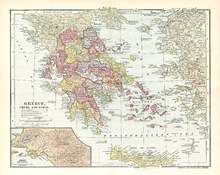
The railways of Greece have a history which begin in 1869, with the completion of the then Athens & Piraeus Railway, with parts of it also becoming the second-oldest underground metro system in the world. The running of the Greek railways is split between the Hellenic Railways Organisation (OSE), which owns and maintains the infrastructure, and TrainOSE, which runs the trains on the network.
Greece is a member of the International Union of Railways (UIC). The UIC Country Code for Greece is 73.
History
Ancient Greece
The Diolkos was a paved trackway near Corinth in Ancient Greece which enabled boats to be moved overland across the Isthmus of Corinth. The shortcut allowed ancient vessels to avoid the dangerous circumnavigation of the Peloponnese peninsula. It is regarded by some as the first railway (as defined as a track to direct vehicles so they may not leave the track) to ever be constructed.
The beginnings (1868–1919)
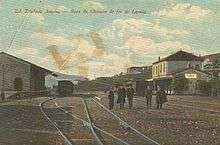

Greek independence in 1832 coincided with the start of the railway era. By 1835 plans were being put to the Greek state to construct a railway line from Athens to the port of Piraeus. Twenty-two years later, in 1857, a contract for its construction was signed and the work commenced. It took four different companies a further twelve years to lay the 8.8 kilometres (5.5 mi) of track, the work being completed in 1869.[2]
Greece towards the end of the 19th century was a collection of small agricultural towns acting as marketplaces and economic centres for the villages that surrounded them. Greece had very little industry and few roads, which made the government think about the development of a railway system that would go towards addressing the lack of internal and external communication that existed. In 1881 the Prime Minister, Alexandros Koumoundouros signed four contracts for the laying of 1,435 mm (4 ft 8 1⁄2 in) standard gauge lines, with the intention of making Greece a pivotal point on the journey between Europe, India and Asia.
In the following year, 1882, Koumoundouros was replaced by Charilaos Trikoupis as Prime Minister, who cancelled the contracts, replacing them with four of his own. He had a different political vision for the railways, seeing them as a way of stimulating the internal growth of Greece and proposed a 417 kilometres (259 mi) narrow-gauge (1,000 mm (3 ft 3 3⁄8 in)) system encircling the northern Peloponnese, with a separate system in Thessaly; linking the port of Volos with the town of Kalambaka on the other side of the Thessalian plain. There was also a line of 76 kilometres (47 mi) to be laid from Athens to Lavrio, on the peninsula of Eastern Attica. Trikoupis preferred narrow gauge over standard gauge due to cheaper initial construction costs, although the line linking Athens to Larissa, which was planned to eventually join with the European system, was constructed to 1,435 mm (4 ft 8 1⁄2 in) standard gauge. The network took 25 years to complete, 20 years longer than the 5 anticipated by Trikoupis.
By 1909, 1,606 kilometres (998 mi) of track had been laid, including the main standard-gauge line to the then Greek-Turkish border at Papapouli, past the Tempi valley (400 km north of Athens). The first trains to run the full 506 kilometres from Athens to Thessaloniki on standard-gauge track marked the completion of the line in 1918, which by then was running entirely on Greek territory.
Integration of networks (1920–1970)

Modern era (OSE) (1971–2000s)
The Hellenic Railways Organisation (OSE) was founded in 1971, taking over from the Hellenic State Railways. Since then, the network of Greece's railways has been extensively modernised and parts of it have been electrified, notably between the cities of Thessaloniki and Larissa; and Athens' International Airport and Kiato.
Urban railways of Athens
Piraeus–Monastiraki–Iraklio–Lavrio–Kifissia
The first railway line that operated in Greece was the one connecting Athens and Piraeus, which opened in 1869. It ran for a distance of 8 km from the port of Piraeus to Thissio in Athens. It was later extended to Omonoia Square in 1895 and electrified in 1904, with the 600V DC third rail system. From 1911 it was also possible to run through freight trains on the Piraeus Harbor Tramway using dual system electric locomotives.

Another company, Attica Railways in 1885, ran a metre-gauge suburban line from Lavrio Square to the north of Omonoia Square and to Iraklio (a northern suburb). It involved a section of street running, along the present 3 September Street, from Lavrio Square to Attiki Square, beyond which it ran on a dedicated trackbed. At Iraklio, the line forked to form two suburban branches. One went further north via Maroussi to Kifissia and Strofyli, with a freight only extension to Dionyssos marble quaries. The other branch ran eastwards to Vrilissia (at a point very near to the present Plakentias station) and then southwards to the villages Peania, Koropi, Marcopoulo, Kalyvia, Keratea, Kamariza and its terminus at the mining town of Lavrio.
In 1926, the Hellenic Electric Railways S.A. (Ελληνικοί Ηλεκτρικοί Σίδηρόδρομοι, ΕΗΣ), a new company, created by the co-operation of Attica Railways S.A. and the English "Power Group", took over operation of the two lines Piraeus-Athens and Omonia and Attiki-Kifissia-Strofyli. In 1929 SPAP (Piraeus, Athens and Peloponnese Railways) took over the Iraklio - Lavrio branch line. The Athens terminal for Lavrio was moved from Lavrio Square to Athens Peloponnese Station.[2] To join the Lavrio line to its network, SPAP built a connection between Agioi Anargyroi (Kato Liosia) and Iraklio (1931). The Lavrio line was eventually closed in 1957, due to political pressures from the road lobby.[3]
The line from Attiki Square to Kifissia operated as a steam locomotive hauled railway with numerous level crossings until 1938. The line was subsequently rebuilt in electrified dual track standard gauge without level crossings, connected to the electrified Athens-Piraeus (EIS) line at Omonoia, and reopened to Kifissia in 1957. The extension to Strofyli was abandoned.
Industrial railways
A number of railway lines were constructed mainly by mining operations and by extensive industrial facilities. There were also a few temporary lines, used for the construction of major public works. Most of them were either meter gauge or 600 mm (1 ft 11 5⁄8 in) narrow gauge.[4]
Military railways (1916-1918)
During World War I, after the collapse of Serbia, Eastern Macedonia was occupied by German and Bulgarian forces and Central and Western Macedonia by French and British troops, thus establishing the Macedonian front. The French and British troops and their Greek allies had extensive military logistics facilities in and around Thessaloniki. Supplies had to be transported to the various front line units. As World War I fronts were relatively static, it was possible to construct railway lines for this purpose. Almost all of these lines were of the Decauville system with a 600 mm (1 ft 11 5⁄8 in) narrow gauge. Some of these lines were completely isolated from existing lines while others started at mainline railway stations.[5]
The most important such railways were the following:[6][7]
- The Tasli to Stavros line at Orfanu Bay.
- The Sarakli (Perivolakion) to Stavros line. This 66 km long line, built by the British Army, was taken over by the Hellenic State Railways (SEK) in 1921. SEK operated this line until 1947. It was preserved on request of the Hellenic Army until 1952, when it was dismantled. The main rolling stock consisted of War Department Baldwin 4-6-0T steam locomotives.[8]
- The Skydra (Vertekop) - Aridaia line. This 42 km long line was handed over after the war to Chemins de fer Vicinaux de Macedoine (1923), which failed to make a profit and the line was taken over by the Hellenic State Railways (SEK) in 1932. SEK closed the line in 1936.
- The Armenochori - Skotsidir line
- The Goumenitsa line
- The Dimitritsi (Gudeli) to Kopriva (Kurfali) line
- The Katerini - Dramista line, a mining line for transport of brown coal (lignite)
Current status
The running of the Greek railways is divided between the Hellenic Railways, which owns and maintains the infrastructure, and TrainOSE, which runs the trains on the network.
OSE
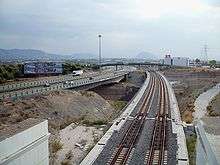
.jpg)

Currently the Hellenic Railways Organisation (OSE) owns and maintains the following lines:[9]
Major rail network
- The main line from Piraeus to Thessaloniki (with its branches at Inoi-Chalkis and Lianokladi-Lamia-Stylis). The sections between Athens-Tithorea and Domokos-Thessaloniki have been extensively modernised and feature an electrified double track, while parts between these two sections are currently undergoing modernisation. A complete high-speed railway line from Athens to Thessaloniki is expected to be complete by the end of 2017.
- The main line from Athens to Corinth–Kiato (Line is mainly used by the Proastiakos commuter rail service).
- The electrified single track line from Thessaloniki to Idomeni.
These lines are electrified with the 25 kV AC 50 Hz system.
Minor rail network
- The standard-gauge single-track line from Platy (branching off from the Athens–Thessaloniki mainline) to Florina and Kozani, forming the Kozani–Amyntaio railway line.
- The standard-gauge single-track line Thessaloniki to Alexandroupolis and Ormenio, with its branch to Promachon at the Greek-Bulgarian borders.
- The standard-gauge lines of Thessaly (Kalambaka and Volos branches), as part of the Thessaly rail network .
Peloponnese metre gauge network
- Metre gauge line from Athens to Patras (although in use after Kiato).
- Metre gauge line from Patras to Pyrgos.
- Metre gauge line from Pyrgos to Olympia.
- Metre gauge line from Pyrgos to Katakolo.
- Metre gauge line from Pyrgos to Zevgolatio (via Kalo Nero),
- Metre gauge line from Corinth to Kalamata (via Argos, Tripoli and Zevgolatio),
- Metre gauge line from Argos to Nafplio,
- Metre gauge line from Kalo Nero to Kyparissia,
- Metre gauge line from Kalamata to Messene.
Tourist rail network
- The 750 mm (2 ft 5 1⁄2 in) narrow-gauge rack railway line from Diakofto to Kalavryta (the Diakofto–Kalavryta Railway)
- The seasonal, 600 mm (1 ft 11 5⁄8 in) narrow-gauge line from Ano Lechonia to Milies (the Pelion railway)
Financial problems
Hellenic Railways operates at a loss of about $3.8 million per day, having accumulated a total debt of $13 billion, or about 5% of Greek GDP (2010). The bulk of this debt was to be maturing by 2014. In 2008, the company reported a loss of more than $1 billion, on sales of about $253 million. Between 2000 and 2009, the cost of the company’s payroll soared by 50 percent even as overall personnel decreased by 30 percent. The average salary of a rail employee is over $78,000.[10] In the mountainous Peloponnese region, trains manned by drivers being paid as much as $130,000 a year frequently run empty. For the better part of a decade, Greece has provided sovereign backing to Hellenic Railways, thus allowing it to borrow billions even though the company’s finances are so skewed that it pays three times as much on interest expenses than it collects in revenue. As the debt of state-owned enterprises was not counted toward Greece’s official debt, Greece has been able to use the rail system as a means to support employment while not adding to its official debt number; basically an accounting trick to hide debt.[10] The Greek government is aware that only the closure of a substantial number of loss-making routes and large employment cuts (between 2500-3500 of the 7000 staff) will make Hellenic Railways attractive to foreign investors. But the Railway Union opposes privatization and threatens with strikes if jobs and benefits are threatened.[10] Nevertheless, some lines have been closed since 2010 (see below).
TrainOSE
Mainline, passenger and freight train services on OSE lines are operated and provided by TrainOSE S.A., a former OSE subsidiary which is now an independent company.
TrainOSE also operates the suburban and commuter rail services of Greece (called Proastiakos), on a modernised network around the cities of Athens, Thessaloniki and Patras. Proastiakos was founded as a separate company, which became later part of TrainOSE.
Due to the financial problems of Greece TrainOSE has come to suspend regional services on following lines:
- Athens - Alexandroupolis (although the connection Thessaloniki - Alexandroupolis remains in service)
- Edessa - Florina
- Patras - Pyrgos - Kalamata
- Kalamata - Messene
- Corinth - Nafplio - Tripoli
Between February 2011 and May 2014, due to the Greek financial crisis and subsequent budget cuts by the Greek government, all international services were suspended,[11] namely:
- Thessaloniki - Skopje - Belgrade
- Thessaloniki - Sofia - Bucharest
- Thessaloniki - Istanbul (Dostluk/Filia Express)
- Athens – Sofia
In May 2014 some international services were re-introduced on the following lines:[12]
Future
A rapid transit system is currently under construction in Thessaloniki, projected to open in 2020.
The Egnatia Railway is a planned railway line between Alexandroupolis and Igoumenitsa, due to begin construction in 2019. The project includes track refurbishment and upgrades, and brand new track between Florina and Krystallopigi, and Kozani to Igoumenitsa. The projected cost of this project is €10 billion.[13]. A new double track, standard gauge railway between Athens and Patras is also currently under construction.[14]
Stations Gallery

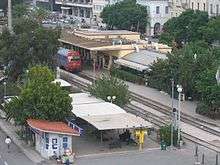 Patras
Patras
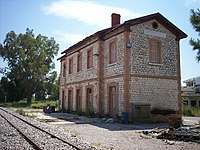 Messolonghi railway station
Messolonghi railway station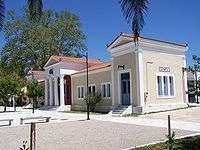 Olympia railway station
Olympia railway station Argos railway station
Argos railway station
Urban Railways
Athens Metro
Athens Metro consists of two underground lines (lines 2 & 3) in Athens' Metropolitan area. The system is owned by Attiko Metro S.A. and is operated by Attiko Metro Etareia Leitourgias S.A. or AMEL. Athens Metro trains also reach Athens International Airport over electrified OSE lines that are also used by the Proastiakos service.
Athens–Piraeus Electric Railways (ISAP)

In 1976 the Hellenic Electric Railways S.A. (EIS, Greek ΕΗΣ), which run the Piraeus–Kifissia line and the Piraeus–Perama light railway were nationalized and the company renamed to Athens–Piraeus Electric Railways S.A. (ISAP, Greek ΗΣΑΠ). The Piraeus-Perama light railway line was closed in 1977.
Today ISAP operates the electrified standard gauge urban rail line from Piraeus to Kifissia; and as such the line is also commonly referred to as Athens' Metro Line 1, although it is operated separately. In 2008 the Greek Government announced plans to construct an extension of the ISAP line from Kifissia to the suburb of Agios Stefanos (formerly Oion).
Thessaloniki Metro
The construction of Thessaloniki metro began in 2006 and Phase 1 of the project is expected to be complete in early 2020. The 9.6 km line will be owned and operated by Attiko Metro S.A..
See also
References
- 1 2 3 4 5 6 "Railway Statistics – 2014 Synopsis" (PDF). Paris, France: International Union of Railways, IUC. 2014. Retrieved 2015-09-09.
- 1 2 "Hellenic Railways (OSE) History" Archived 2009-10-30 at the Wayback Machine., Organismós Sidirodrómon Elládos. Retrieved on November 16, 2009.
- ↑ G. Nathenas; A. Kourbelis; T. Vlastos; S. Kourouzidis; V. Katsareas; P. Karamanis; A. Klonos; N. Kokkinos (2007). Από τα Παμφορεία στο Μετρό (in Greek). 2. Athens: Μίλητος (Militos). pp. 537–834. ISBN 978-960-8460-91-1.
- ↑ I. Zartaloudis, D. Karatolos, D. Koutelidis, G. Nathenas, S. Fasoulas, A. Filippoupolitis, A. (1997). Οι Ελληνικοί Σιδηρόδρομοι (Hellenic Railways) (in Greek). Μίλητος (Militos). pp. 290–299. ISBN 960-8460-07-7.
- ↑ A. Deligiannis & D. Papadimitriou (1987–1988). "The train of Stavros" (PDF). Makedonika. Thessaloniki: Etereia Makedonikon Spoudon. 26 (80). External link in
|publisher=(help) - ↑ I. Zartaloudis, D. Karatolos, D. Koutelidis, G. Nathenas, S. Fasoulas, A. Filippoupolitis, A. (1997). Οι Ελληνικοί Σιδηρόδρομοι (Hellenic Railways) (in Greek). Μίλητος (Militos). pp. 280–289. ISBN 960-8460-07-7.
- ↑ Keith Taylorson (1996). Narrow gauge at war 2. East Harling, UK: Plateway Press. pp. 82–90. ISBN 1-871980-29-1.
- ↑ Organ, J. (2006). Greece Narrow Gauge. Middleton Press. ISBN 1-904474-72-1.
- ↑ "Network Statement 2007" (PDF). Archived from the original (PDF) on 2008-04-11. (1.29 MB). EDISY S.A., Athens, 2006.
- 1 2 3 "Greek Rail System's Debt Adds to Economic Woes". New York Times. 21 July 2010.
- ↑ International Trains to Greece Halted - InterRail Archived 2011-04-16 at Archive.is
- ↑ TrainOSE - International Railway Services
- ↑ ‘Egnatia Railway’ European Commission
- ↑ ERGOSE - Investment Program, 30 March 2016
Further reading
- I. Zartaloudis, D. Karatolos, D. Koutelidis, G. Nathenas, S. Fasoulas, A. Filippoupolitis, A. (1997). Οι Ελληνικοί Σιδηρόδρομοι (Hellenic Railways) (in Greek). Μίλητος (Militos). ISBN 960-8460-07-7. It is the only extensive and authoritative source for the history of Greek railways until 1997.
- Simms, W.F. (1997). The railways of Greece. Wilfried F. Sims. ISBN 0-9528881-1-4. Contains brief history, simple line maps and extensive list of rolling stock until 1997.
- Organ, John (2006). Greece Narrow Gauge: featuring the Thessaly and the Peloponnese systems. Narrow Gauge Branch Lines series. Midhurst, West Sussex, UK: Middleton Press. ISBN 1904474721.
- Greece — Railway Map (2nd Edition). London, UK: The Quail Map Company. 1992. ISBN 0-900609-85-0. External link in
|publisher=(help) - ERAIL Greece monograph, report submitted to the European Commission, DG Transport and Energy, Version 6, Rijswijk, The Netherlands, 2005.
External links
| Wikimedia Commons has media related to Rail transport in Greece. |
